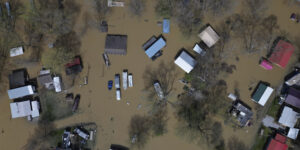Search-and-rescue teams made their way into the Florida Keys’ farthest reaches Tuesday, while crews labored to repair the single washed-out highway connecting the islands and rush aid to Hurricane Irma’s victims. Federal officials estimated one-quarter of all homes in the Keys were destroyed.
Two days after Irma roared into the island chain with 130 mph winds, residents were allowed to return to the parts of the Keys closest to Florida’s mainland. But the full extent of the damage remained a question mark because communications and access were cut off.
Federal Emergency Management Agency administrator Brock Long said while the assessment of damage was constantly changing, preliminary estimates suggested that in addition to the destroyed dwellings, 65 percent of homes in the Keys sustained major damage.
“Basically every house in the Keys was impacted,” he said.
Statewide, as many as 13 million people – two-thirds of Florida’s population – were without electricity in the tropical heat, and officials warned it could take 10 days or more for power to be fully restored. About 110,000 remained in shelters across Florida.
Seven deaths in Florida have been blamed on Irma, along with three in South Carolina and two in Georgia. At least 35 were killed in the Caribbean.
“We’ve got a lot of work to do, but everybody’s going to come together,” Florida Gov. Rick Scott said. “We’re going to get this state rebuilt. This state is a state of strong resilient people.”
The Keys appeared to be the hardest-hit part of Florida, even though the 400-mile-wide storm engulfed nearly the entire state. Drinking water was cut off, all three of the islands’ hospitals were closed, and the supply of gas was extremely limited.
Officials said it was not known how many people ignored evacuation orders to stay behind in the Keys.
“It’s going to be pretty hard for those coming home,” said Petrona Hernandez, whose concrete Plantation Key home with 35-foot walls was unscathed, unlike others a few blocks away. “It’s going to be devastating to them.”
An aircraft carrier was positioned off Key West to help in the search-and-rescue effort. And crews worked to repair two washed-out, 300-foot sections of U.S. 1, the lone highway from the mainland, and check the safety of the 42 bridges linking the islands.
Authorities were stopping people to check documentation such as proof of residency or business ownership before allowing them back into the Upper Keys, including Key Largo, Tavernier and Islamorada.
But the Lower Keys – including the chain’s most distant and most populous island, Key West, with 27,000 people – were still off-limits, with a roadblock in place where the road was washed out.
Corey Smith, a UPS driver who rode out the hurricane in Key Largo, said though it was a relief that many buildings on the island escaped major damage, those who sought to return should recognize conditions were still not good, with branches blocking roads and supermarkets remaining closed.
“They’re shoving people back to a place with no resources,” he said by telephone. “It’s just going to get crazy pretty quick.”
Lower Keys resident Leyla Nedin said she doesn’t plan to return anytime soon to her home near where Irma came ashore on Cudjoe Key.
“We are still without water, power, sewer, gas and cell service,” she said. “My concern is that even if we get to go in to the Lower Keys, our fragile infrastructure could be even more compromised.”
Irma’s rainy remnants, meanwhile, pushed through Alabama and Mississippi after drenching Georgia. Flash-flood watches and warnings were issued around the Southeast.
In a parting blow as Irma exited Florida, it caused record flooding in the Jacksonville area, where the sheriff’s office reported rescuing at least 356 people. On its Twitter account, said it hopes “people who had their lives saved yesterday will take evacuation orders seriously in the future.”
Eddie Hinan waded through knee-deep water to reach his flooded apartment in the San Marco neighborhood of Jacksonville on Tuesday, staying just long enough to grab a plastic bag of clean clothes. His girlfriend, Deborah Smith, waited behind, struck by the devastation around her.
“I just started crying,” she said. “I already knew it was gone, the apartment and everything in it. We lost everything.”
(Mendoza reported from Atlanta. Associated Press writers Terry Spencer in Palm Beach County; Gary Fineout and Joe Reedy in Tallahassee; Jay Reeves in Immokalee; Terrance Harris in Orlando; Claire Galofaro in Jacksonville; and Jason Dearen, Jennifer Kay, Curt Anderson and David Fischer in Miami contributed to this report.)





















 Buyer-Friendly April Reinsurance Renewal Bodes Well for Mid-Year Renewals: Brokers
Buyer-Friendly April Reinsurance Renewal Bodes Well for Mid-Year Renewals: Brokers  Contractors Insurance Alert: Construction Defect Lawsuits Rising
Contractors Insurance Alert: Construction Defect Lawsuits Rising  The Workplace Is Changing; So Are the Risks for Employment Discrimination Claims
The Workplace Is Changing; So Are the Risks for Employment Discrimination Claims  Allstate: How Can You Save on Auto Insurance?
Allstate: How Can You Save on Auto Insurance? 







